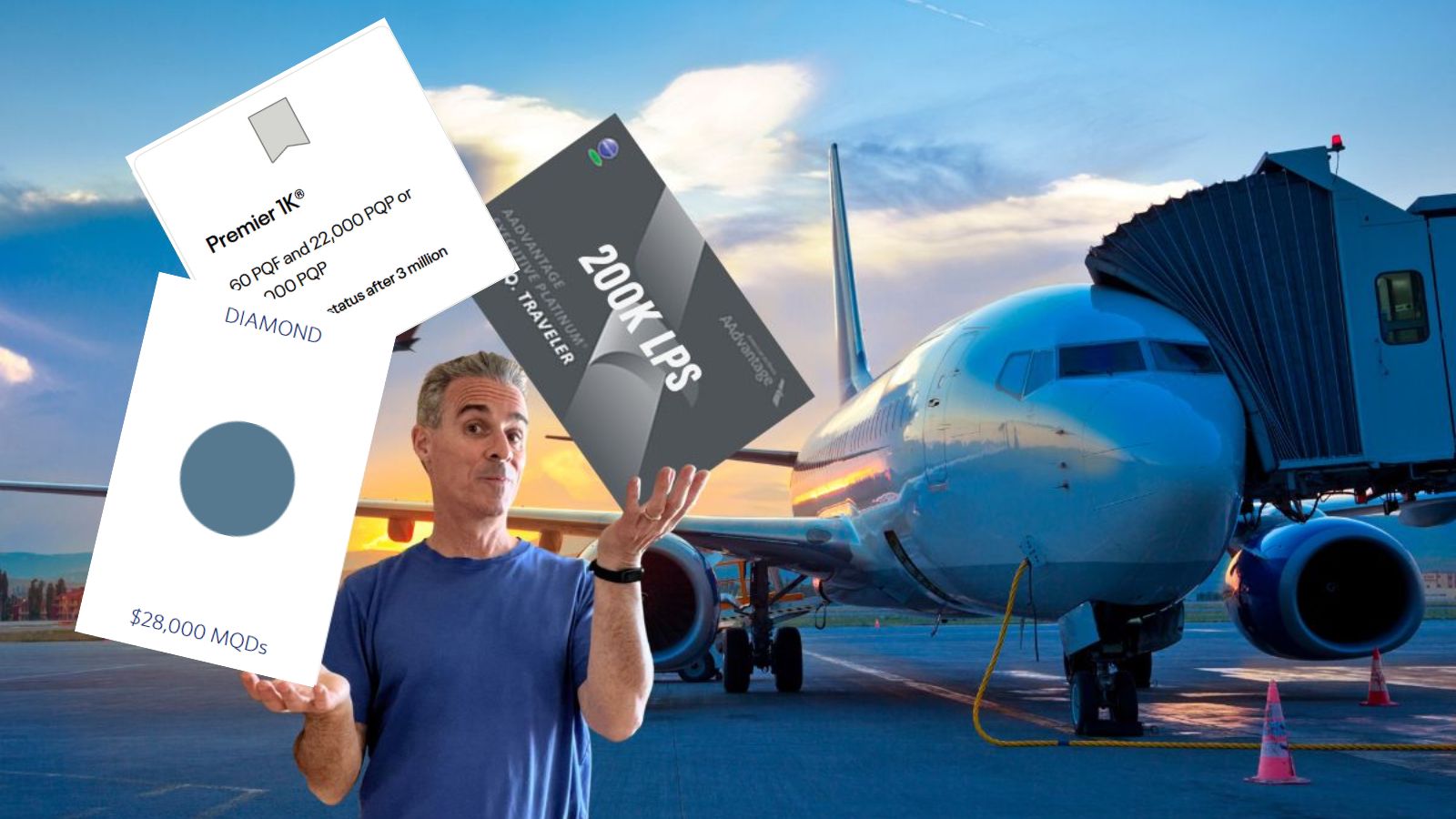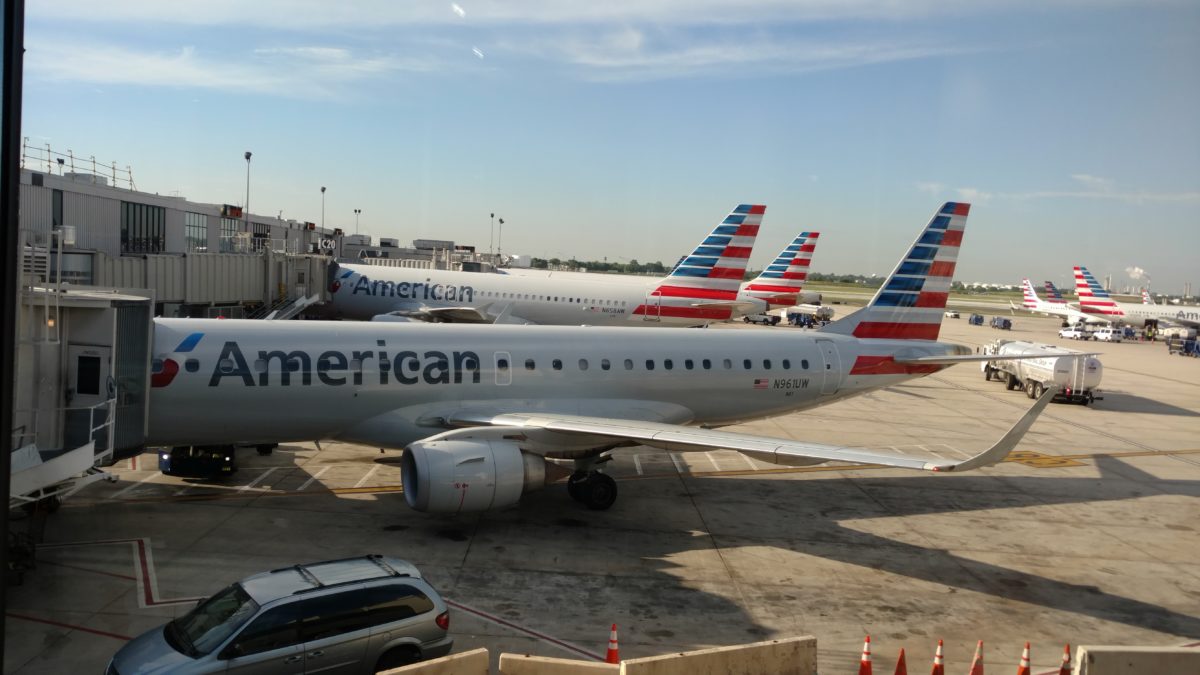American Airlines, Delta, United, Alaska, and several other airlines offer four tiers of elite status. Each of these loyalty programs allows you to earn top-tier status through credit card spend alone. I found it interesting to compare the programs side by side to see which requires the least spend. Note that I’m not recommending this approach. Airline elite status isn’t usually valuable if you don’t fly the airline often, so most would do better earning status through a combination of flying and credit card spend (or other means, which vary by program).

Elite Requirements
Here’s a summary of the requirements for achieving each level of elite status with each airline:
| American | Gold | Platinum | Platinum Pro | Executive Platinum |
|---|---|---|---|---|
| Loyalty Points (LPs) Required | 40K | 75K | 125K | 200K |
| Delta | Silver | Gold | Platinum | Diamond |
| Medallion Qualifying Dollars (MQDs) Required | 5K | 10K | 15K | 28K |
| United | Silver | Gold | Platinum | 1K |
| Premier Qualifying Points (PQP) Required | 6K | 12K | 18K | 28K |
| w/ Premier Qualifying Flights (PQF) | 5K PQP +15 PQF |
10K PQP +30 PQF |
15K PQP +45 PQF |
22K PQP +60 PQF |
| Alaska 2025 | MVP | MVP Gold | MVP Gold 75K | MVP Gold 100K |
| Elite Qualifying Miles (EQMs) Required | 20K | 40K | 75K | 100K |
| Alaska 2026 | Silver | Gold | Platinum | Titanium |
| Status Points (SPs) Required | 20K | 40K | 80K | 135K |
| JetBlue | Mosaic 1 | Mosaic 2 | Mosaic 3 | Mosaic 4 |
| Tiles Required | 50 | 100 | 150 | 250 |
| Frontier | Silver | Gold | Platinum | Diamond |
| Elite Status Points (ESPs) Required | 10K | 20K | 50K | 100K |
Credit Cards
Elite earning rates and elite bonuses vary by credit card. Here’s a summary of the earning rates of relevant cards available in the United States:
| AA Cards | Elite Earnings for Spend | Elite Bonuses |
|---|---|---|
| Citi AAdvantage MileUp Card | 1 LP per $ | N/A |
| Citi AAdvantage Platinum Select | 1 LP per $ | N/A |
| CitiBusiness AAdvantage Platinum Select | 1 LP per $ | N/A |
| Barclays AAdvantage Aviator Red | 1 LP per $ | N/A |
| Barclays AAdvantage Aviator Silver | 1 LP per $ | Up to 15,000 bonus Loyalty Points per status qualification period: Earn 5K bonus LPs at $20K spend, $40K spend, and $50K spend. |
| Citi® / AAdvantage® Executive | 1 LP per $ | Up to 20,000 bonus Loyalty Points: 10K after earning 50K LPs through all channels and another 10K after earning 90K LPs through all channels |
| Delta Cards | Elite Earnings for Spend | Elite Bonuses |
| Delta SkyMiles® Platinum American Express Card | 1 MQD per $20 | $2,500 MQDs per year |
| Delta SkyMiles® Platinum Business American Express Card | 1 MQD per $20 | $2,500 MQDs per year |
| Delta SkyMiles® Reserve American Express Card | 1 MQD per $10 | $2,500 MQDs per year |
| Delta SkyMiles® Reserve Business American Express Card | 1 MQD per $10 | $2,500 MQDs per year |
| United Cards | Elite Earnings for Spend | Elite Bonuses |
| The United℠ Business Card | 1 PQP per $20 (max 4K PQP) |
N/A |
| The United Quest℠ Card | 1 PQP per $20 (max 18K PQP) |
1,000 PQPs per year (starting 2026) |
| The United Club℠ Card | 1 PQP per $15 (max 28K PQP) |
1,500 PQPs per year (starting 2026) |
| The United Club℠ Business Card | 1 PQP per $15 (max 28K PQP) |
N/A |
| Alaska Cards | Elite Earnings for Spend | Elite Bonuses |
| Atmos™ Rewards Ascent Visa Signature® Card | 1 SP per $3 | N/A |
| Atmos™ Rewards Business Visa Card | 1 SP per $3 | N/A |
| Atmos™ Rewards Summit Visa Infinite® Card | 1 SP per $2 | 10K status points each anniversary |
| JetBlue Cards | Elite Earnings for Spend | Elite Bonuses |
| JetBlue Plus Mastercard | 1 Tile per $1K | N/A |
| JetBlue Business Card | 1 Tile per $1K | N/A |
| JetBlue Premier Mastercard | 1 Tile per $1K | N/A |
| Frontier Card | Elite Earnings for Spend | Elite Bonuses |
| Frontier Airlines World MasterCard® | 1 ESP per $1 | N/A |
Spend Required
In the following table, I’ve documented the spend required to earn each level of status entirely through credit card spend. With Delta, I assumed that all spend would be on a Delta Reserve card since the Reserve card earns twice as many MQDs per dollar as the SkyMiles Platinum card. Similarly, with United, I assumed that all spend would be on a Club card, which earns 1 PQP per $15 (vs 1 PQP per $20 with other cards). And with Alaska, for the 2026 analysis, I assumed that all spend would be on the Summit Visa card, which earns 1 Status Point per $2. However, for comparison purposes, I also kept the original Alaska numbers, titled “Alaska 2025 (pre-Atmos),” where I assumed earning 1 EQM per $3.
| American | Gold 40K LPs |
Platinum 75K LPs |
Platinum Pro 125K LPs |
Executive Platinum 200K LPs |
Annual Fees |
|---|---|---|---|---|---|
| Most AA cards | $40K | $75K | $125K | $200K | Up to $99 |
| Aviator Silver1 | $35K | $60K | $110K | $185K | $195 |
| AA Exec2 | $40K | $65K | $105K | $180K | $595 |
| Silver & Exec3 | $35K | $50K | $90K | $165K | $790 |
| Delta | Silver 5K MQDs |
Gold 10K MQDs |
Platinum 15K MQDs |
Diamond 28K MQDs |
Annual Fees |
| Delta Reserve4 | $25K | $75K | $125K | $255K | $650 |
| w/ 2nd card | $0 | $50K | $100K | $230K | $1,000 |
| w/ 3rd card | $0 | $25K | $75K | $205K | $1,350 |
| w/ 4th card | $0 | $0 | $50K | $180K | $2,000 |
| United | Silver 6K PQP |
Gold 12K PQP |
Platinum 18k PQP |
1K 28K PQP |
Annual Fees |
| Club Business Card5 | $90K | $180K | $270K | $420K | $695 |
| Club Card6 | $67.5K | $157.5K | $247.5K | $397.5K | $695 |
| w/ Quest Card | $52.5K | $142.5K | $232.5K | $382.5K | $1,045 |
| Alaska 2025 (pre-Atmos) |
MVP 20K EQMs |
MVP Gold 40K EQMs |
MVP Gold 75K 75K EQMs |
MVP Gold 100K 100K EQMs |
Annual Fees |
| Consumer or Biz card | $60K | $120K7 | $225K7 | $300K7 | $95 |
| Alaska 2026 | Silver 20K SPs |
Gold 40K SPs |
Platinum 80K SPs |
Titanium 135K SPs |
Annual Fees |
| Summit Visa8 | $20K | $60K | $140K | $250K | $395 |
| JetBlue | Mosaic 1 50 Tiles |
Mosaic 2 100 Tiles |
Mosaic 3 150 Tiles |
Mosaic 4 250 Tiles |
Annual Fees |
| Plus or Business Card | $50K | $100K | $150K | $250K | $99 |
| Frontier | Silver 10K ESPs |
Gold 20K ESPs |
Platinum 50K ESPs |
Diamond 100K ESPs |
Annual Fees |
| Frontier card | $10K | $20K | $50K | $100K | $99 |
2) The AA Executive Card offers 10K bonus LPs after earning 50K LPs through all channels and another 10K after earning 90K LPs through all channels
3) Assumes that the first $50K spent is with the Aviator Silver card in order to earn each of its LP bonuses
4) The Delta Reserve and Delta Reserve Business cards earn twice as many MQDs per dollar as their SkyMiles Platinum counterparts, so I assumed that all spend is on Delta Reserve cards. Each card that you have, regardless of whether you put spend on it, gives you a $2,500 MQD Headstart.
5) The Club Business and consumer Club Cards offer 1 PQP per $15, which is better than 1 per $20 offered with the United Quest and United Business cards. Therefore, I assumed that all spend is on Club cards.
6) The consumer United Club card offers a 1.5K PQP head start each year in which your card has been open at least since 12/31 of the prior year. Similarly, the Quest card offers an annual 1K PQP head start, starting in 2026. Simply having these cards gets you closer to elite status.
7) This number is shown for comparative purposes only. Prior to 2026, Alaska limits cardholders to earning 30K EQMs per year through credit card spend.
8) The Alaska Atmos Summit card offers 10K Status Points per year beginning with your first cardmember anniversary.
Analysis
Across the board, Frontier offers the cheapest path to elite status. It has the lowest required spend and the lowest credit card annual fees. That said, Frontier also has a very limited network with which you can use elite benefits.
United Airlines is at the other extreme. United requires the most credit card spend for each tier of status. Worse, United also has the most expensive credit card ($695 per year) for unlocking the best elite earnings per dollar.
Beyond Frontier and United, results vary based on which elite tier you’re interested in…
Tier 1 status: Delta and Alaska offer the best paths to first-tier status. Alaska requires only $20K spend (assuming you obtained the Summit card the prior year so that you’re eligible for the card’s 10K Status Points each cardmember anniversary). Delta requires spending anywhere from $0 to $25K (depending on the number of Delta credit cards you have). AA requires $40K spend, and JetBlue requires $50K.
Tier 2 status: Alaska, AA, and Delta offer the best paths to second-tier status. Alaska requires a $60K spend; AA requires $50K to $75K (depending on the specific cards you have), and Delta requires $0 to $75K (depending on the number of Delta cards you have). JetBlue requires $100K.
Tier 3 status: AA and Delta offer the best paths to third-tier status, closely followed by Alaska and JetBlue. AA requires $90K to $125K (depending on the specific cards you have), and Delta requires $50K to $125K (depending on the number of Delta cards you have). Alaska requires $140K and JetBlue requires $150K.
Tier 4 status: AA is the champion of this tier. AA requires $165K to $200K (depending on the specific cards you have). If you’re willing to put up with a ton of annual fees, you can do nearly as well with Delta. Delta requires $180K to $255K (depending on the number of Delta cards you have). Both Alaska and JetBlue require $250K.
Conclusion
If you fly Frontier often, you can’t beat Frontier’s low spend requirements to reach each status tier.
AA and Alaska fliers interested in low-level status (tier 1 or 2) would do well to put their spend on the Atmos Summit card. That said, those interested in higher-level status may be better off with AA cards. Thanks to AA and Alaska’s partnership, status from either airline can be helpful even when flying the other airline. Of course, this recommendation is based solely on earning status through credit card spend. It doesn’t factor in different ways of earning status points, accelerating status (through Milestone Rewards, for example), or the relative value of each program’s elite status tiers.
Delta is in a category of its own. If you’re not concerned about annual fees, you can achieve tier 2 status (Delta Gold) without any spend by holding four Delta cards. While it sounds insane to spend $2,000 per year in annual fees, keep in mind that each card offers additional value beyond elite status. Each Delta Reserve card offers 15 Sky Club visits per year, a round-trip first-class companion certificate, Delta Stays rebates, and more. And each Delta Platinum card offers a round-trip economy companion certificate, Delta Stays rebates, and more.
United fliers? They’re out of luck. The amount of spend required to attain United elite status is crazy high compared to the others. JetBlue isn’t as bad as United, but it’s not competitive unless you’re looking to earn tier 3 or 4 status.





Are you sure the Alaska 2026 is correct? It was my understanding your receive 1 point per dollar spent on all other purchases. Wouldn’t that mean you only need to charge $135,000 on a Summit credit card to get Titanium status?
I re-read the rules. I am incorrect.
AA 250k loyalty point threshold is the sweet spot for me! Free MCE seats, EP status, and 85k bonus miles from the loyalty point rewards.
I played this game with various airline and hotel credit cards when it made sense. Now these cards are not worth the game. Spend 60K on any cash back credit card and if you qualify (business account) you get 2.75% cash back. That is $1,650. You can but a business class ticket on most airlines and get all the perks. No game, no annual fee and you are not restricted to any airline.
In the past, my travel only took me to mid tier elite, now being able to combine with credit card spend, I can reach top tier elite. This is the true benefit.
Diamond Choice Benefits for Amex Statement credit dropping to $500 and Platinum Choice Benefit for Amex dropping to $200 for 2027 Medallion Year.
Is that info published somewhere?
UA Explorer card also earns 1PQP for every $20 spent, but it’s capped at 1K PQP.
I’d guess that a person who can put $150k to $200k of “real” spending on an airline credit card would likely purchase premium cabin tickets. Which come with most benefits that tier status affords. Also, that same person is likely to be flying enough to earn tier status organically. And then there’s MSers.
For JetBlue each time you reach a new mosaic tier, you have perks, one of which is gifting yourself 20 tiles. You can only gift to yourself once. So it would take $50K for Mosaic 1 but only $80K for Mosaic 2. If you are in two player mode then someone could gift your 20 tiles. So a wildcard option would be only $30K to Mosaic 1, $60K to 2, $110K to 3, etc.
Thanks for that detail. Some of the other programs listed here also offer milestone rewards that can help accelerate the path to the next level of elite status. I thought it would be too complicated to model, especially since some people may choose different milestone rewards, so I left it out of this analysis.
So if I have a personal and a business Alaska card, can I do 30K +30K via credit card spending and 40K with flights credits to get the top tier. That would require $180k in CC spending.
This year. Next year, the aggregate moves to 135k status points. If your personal card were the Summit, you’d have 25k additional status points. 10k additional status points from just holding the card. 15k additional status points from spending (due to 1sp / $2 spent versus 1sp / $3 spent).
[…] if you have that much spend in you: Elite status via credit card spend: AA vs Delta vs United vs Alaska vs JetBlue vs Frontier. Oh, how did Frontier get in there, […]
Does Delta clawback MQDs if you decide to cancel any of the Amex Delta cards mid-year (i.e., after the MQD boost has been posted)?
I don’t think so, but I’m not 100% sure. They don’t claw back Delta companion tickets so I’d bet they don’t claw back MQDs
Greg – Well written article, stating succinctly info available (if one diligently digs for it).
QUESTION:
Looking forward to 2026, AA will be moving its CC partnership strictly to Citi. We have been told that Barclaycard holders will have their accounts moved to Citi.
However, as we see in the charts that you displayed, there is a serious benefit holding both Citi and Barclay AA affiliated cards.
Getting insight on how this is managed is critical information that we need.
1) IF Citi moves my Barclaycard Silver to Citi, will I still be grandfathered into the 15,000 LP offering, or will the “you can only earn those bonuses from one card” mentality exist?
2) IF Citi does not keep the Barclaycard benefits separate for transitioned AA cardholders, then it is obvious that there is NO benefit to allow them to do this. It would be better for us to cancel our Barclaycard accounts at the end of this Loyalty Point year, and apply for Citi cards separately to get card acquisition bonus miles.
Do you have insight on how (and when) this will be done and how they plan to do this transition?
Thanks, and I look forward to your response.
The original Citi/AA announcement said ““Barclays cardmembers will continue to experience the same benefits they do today.” This suggests to me that Silver cardholders will keep the ability to earn up to 15K bonus LPs. Beyond that little pearl of info, I don’t have any more knowledge about what will happen or when
Thanks Greg.
I think this info will be critical for all the Barclaycard holders.
Getting them to be more specific in as early as October would be critical for those of us that get some status from spend.
Additionally, AA shopping portal bonuses also earn LP. You can easily earn Gold without flying or spending on CC at all. I did this last year, mainly with meal kits.
And, for some, the AA hotel portal can yield north of 10X LPs on stays. Typically, modestly priced properties on three-day stays.
Spent my way to mosaic 2 last year only to have them pull out of LAX. Literally never used my status after I qualified.
Your information is dated. It used to be that credit card spend on Delta Reserve Amex could get you Platinum or Diamond .. No longer .. Those MQDs now need to be spent on Delta Flights, not just any random credit card charge
That’s not true
Totally not true. I put business spend on my delta business reserve and I get the mqds